Who says you need a fancy office to close deals? The right sales tools can transform any space into a powerhouse for your sales team. Doesn’t matter if you’re in a cozy home office or a bustling cafe; these tools can power up your sales process and drive results. Ready to take your sales game to the next level? Let’s jump right in!
What is a tool for sales?
A tool for sales is software or applications designed to enhance the efficiency and effectiveness of the sales process. These tools assist sales teams in managing customer relationships, automating tasks, analyzing sales data, and improving communication and productivity.
Tools for sales: at a glance
The sales technology landscape has grown dramatically in recent years and is now vast and complex. Some key points about the current landscape are:
- Rapid expansion: The number of sales tools has increased from around 400 to over 1000 across 50 different categories in just a few years.
- Diverse categories: The landscape includes tools for CRM, sales enablement, analytics, automation, content management, coaching, engagement, intelligence, HR, like leave management systems, and many more specialized functions.
- Overwhelming options: With so many tools available, 66% of salespeople report feeling overwhelmed by the number of tools at their disposal.
- Underutilization: Despite the abundance of tools, about 30% of SaaS solutions sit idle in organizations, which leads to significant overspending on technology.
- Emerging technologies: The landscape now includes futuristic tools powered by AI, machine learning, big data, and IoT, as well as solutions like the best retail POS system to support seamless sales transactions.
- Focus areas: There’s been significant growth in account targeting tools (1175% growth from 2017-2019) and increased use of data for identifying qualified accounts and target markets.
- Content importance: Content has become an indispensable revenue driver, with buyers placing high importance on relevant, personalized, industry-specific content.
- Market growth: The sales intelligence market specifically is projected to grow from $4.39 billion in 2024 to over $10 billion by 2032, with a CAGR of 11.2%.
- Key players: Industry leaders like LinkedIn, Oracle, and Woodpecker are driving innovation in the space, integrating AI and other advanced technologies into their offerings.
The key takeaway is that while the sales technology landscape offers immense potential, organizations need to be strategic in their tool selection. It’s to avoid overload and ensure effective utilization.
If you sell in retail or at events, consider digital signage software to turn foot traffic into pipeline—show dynamic offers, surface QR codes for instant capture, and sync scans straight to your CRM.
17 key tools for sales you need to check out
In our quest to find the best sales software, we analyzed various features, user reviews, ratings, and pricing. We aimed to bring you a curated list of the top sales tools to speed up your sales process. Keep reading to discover the right sales tools to transform your sales strategy and drive more sales.
Woodpecker – best for cold email outreach
Woodpecker is a top-notch sales tool made for companies and agencies that want to send personalized cold emails known to get great results.
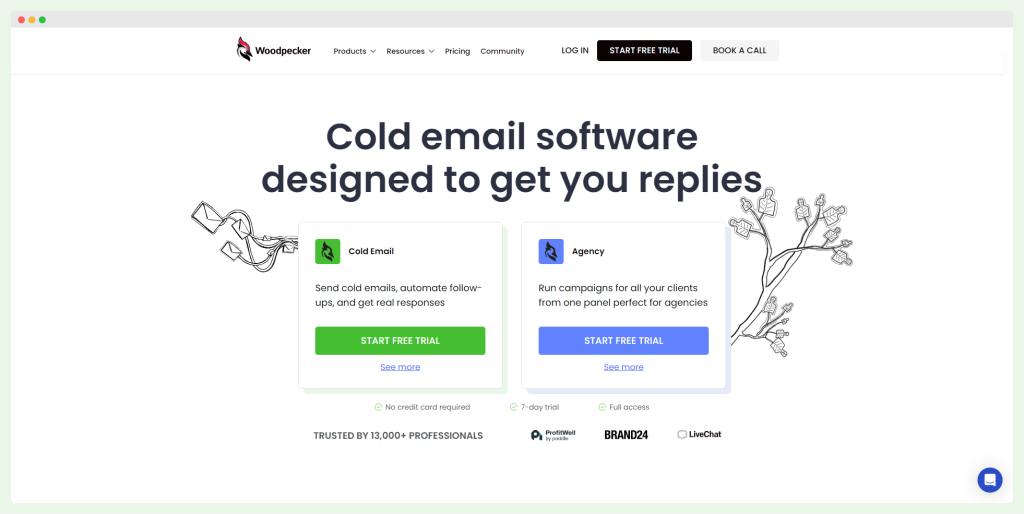
It offers a comprehensive suite of features to improve your email outreach. Woodpecker features:
- Human sending patterns with a random time interval to avoid spam filters.
- Real-time email verification to prevent bounces and protect your domain reputation.
- Custom tracking domains for safe click tracking.
- Deliverability monitor to track sending processes and trends.
- Sending volume monitor to avoid exceeding email provider limits.
- Custom fields (snippets) to personalize campaigns at scale.
- Conditional messaging based on prospect behavior.
- Time zone matching for sending emails at the optimal time.
- Automated follow-ups and email sequences.
- Reply detection to stop sequences when a prospect responds.
- A/B testing with up to five variations to optimize outreach.
- Follow-ups in the same email thread for continuity.
- Native integration with CRM tools like HubSpot, Salesforce, and Pipedrive.
- Compatible with other business tools like Calendly, Google Sheets, LeadFuze, UpLead, and Hunter.
Pricing: Woodpecker has customizable plans starting at $20 per month with additional add-ons like advanced campaigns and API keys. It offers a 7-day free trial to test out the features.
User rating: 4.7/5
Woodpecker stands out as an exceptional cold email outreach tool that offers unparalleled deliverability, personalization, reporting, and automation features. It also comes with remarkable ease of use and stellar customer service. See what the reviews say:
- “Solid product that’s easy to use, great support. It doesn’t do everything that a full-featured sales engagement solution does, but it does what it does very well (cold emailing) and is easy to use.” Capterra
- “I have been using Woodpecker every day for several years on my agency account. In my opinion, it is the best cold mailing tool. The platform is intuitive despite its advanced features. Even new members of our team can quickly create and manage campaigns on their own.” G2
- “The interface is intuitive, the platform doesn’t “get in your way”. Other enterprise sales engagement tools are bulky and have a steeper learning curve. Woodpecker respects principles of email deliverability and the team was great during initial onboarding.” G2
Its integration capabilities and user-friendly interface make it a valuable asset for sales teams. If you’re looking to enhance your outreach and achieve better results, Woodpecker is your go-to!
Try Woodpecker today and transform your email campaigns!
Apollo – best for sales intelligence
Apollo is an end-to-end sales intelligence, engagement, prospecting, and closing platform.
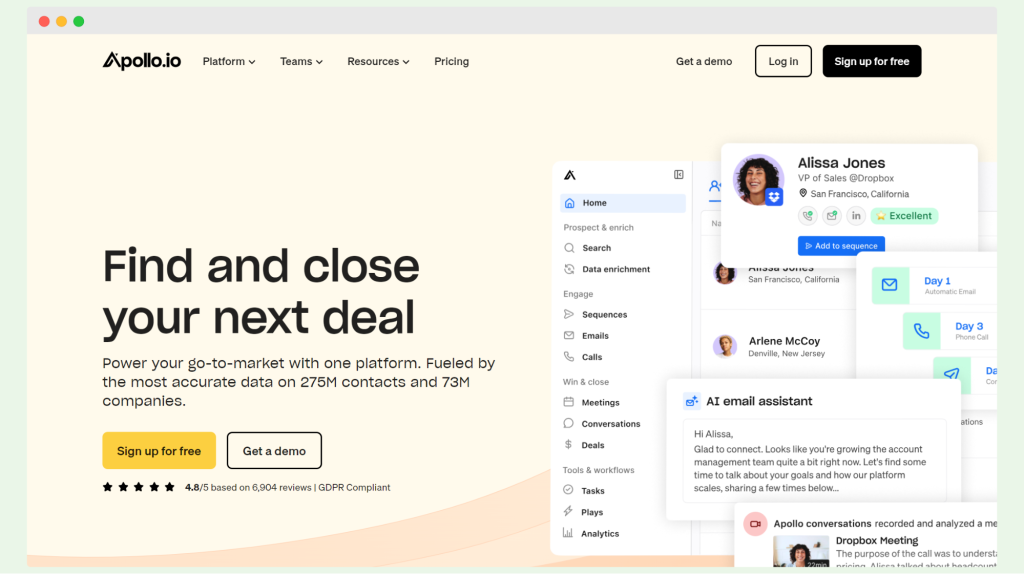
It has tools for lead sourcing, enrichment, prospecting, scoring, and closing deals. Apollo offers a Chrome extension for seamless communication in Gmail and LinkedIn. It also supports the easy creation and launch of email and call sequences, both manually and AI-built.
Pricing: The platform starts at $49 per user per month with unlimited email credits, and a free plan is available.
User rating: 4.8/5 (G2)
However, the pricing is not flexible for smaller teams, and customer support is often criticized as unsatisfactory. While Apollo integrates well with CRMs like HubSpot and has a good search function, these shortcomings might be a dealbreaker for some users.
Breakcold – best for customer relationship management
Breakcold is a sales CRM and pipeline management software for agencies, startups, and consultants that also lets you send cold emails.
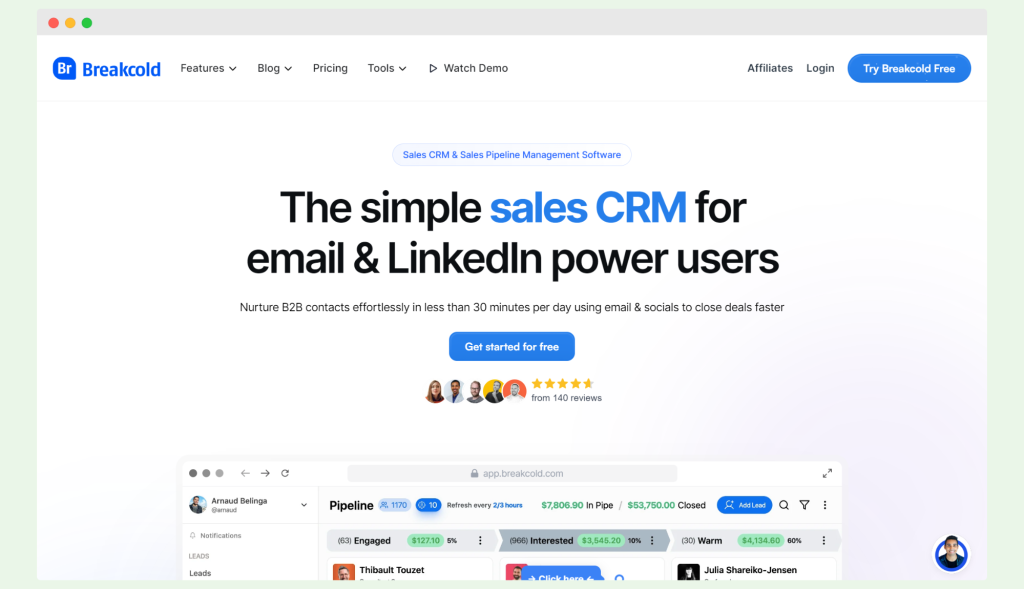
It provides a unified inbox for CRM emails, personalizing capabilities for emails, and automatic rotation of email domains.
Pricing: Breakcold offers two pricing packages, starting at $29/user/month, with a free trial available but no free plan.
User rating: 4.7/5 (G2)
Despite its comprehensive features, Breakcold has a steep learning curve and users report integration issues and occasional bugs. The software lacks advanced analytics, and filtering can be cumbersome without proper initial tagging.
Additionally, Breakcold is not as focused on cold emailing as other alternatives, which could limit its effectiveness for certain sales processes.
HubSpot – best for inbound sales
HubSpot is a leading sales platform that caters to various aspects of the sales process.
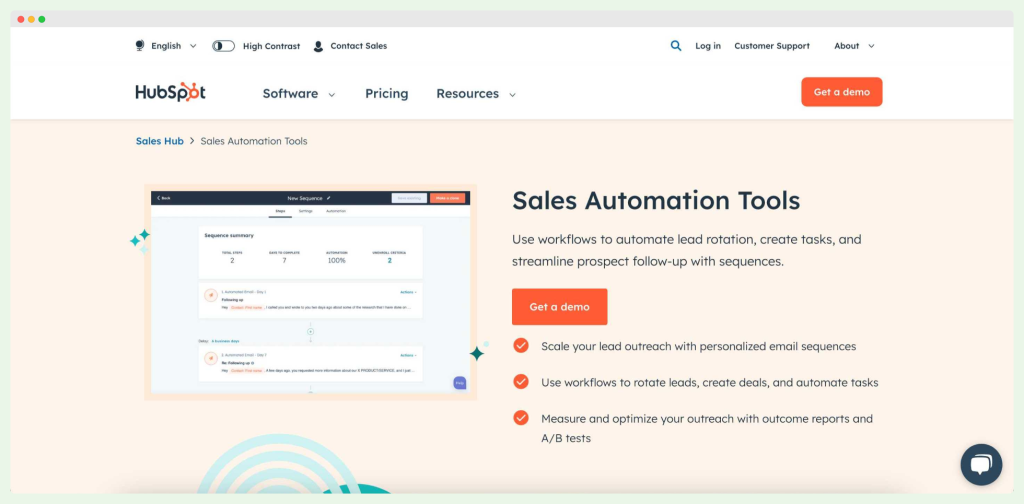
It offers four solutions:
- HubSpot Sales Free,
- HubSpot CRM,
- HubSpot Sales Professional,
- HubSpot Sales Hub Enterprise.
HubSpot provides tools that enhance every aspect of inbound sales strategies, such as email templates, sales content, and detailed visitor data for targeting decision-makers. When paired with third-party tools like chatbots or call center integrations for HubSpot, it becomes a powerful engine that can adapt to any sales scenario.
Pricing: Depends on the packages, but the starter plan for the CRM is $49/month.
User rating: 4.⅘ (G2)
HubSpot’s packages can become expensive quickly and require annual contracts with no early termination options. The platform’s lower plans lack A/B testing, and additional technical support and onboarding services are costly. It’s also quite rigid, so there isn’t much customization.
HubSpot is powerful, but small businesses might find better pricing with alternatives offering similar features.
Reply.io – best for multichannel outreach
Reply.io is a robust sales engagement platform that supports multichannel outreach, including email, calls, and social media interactions.
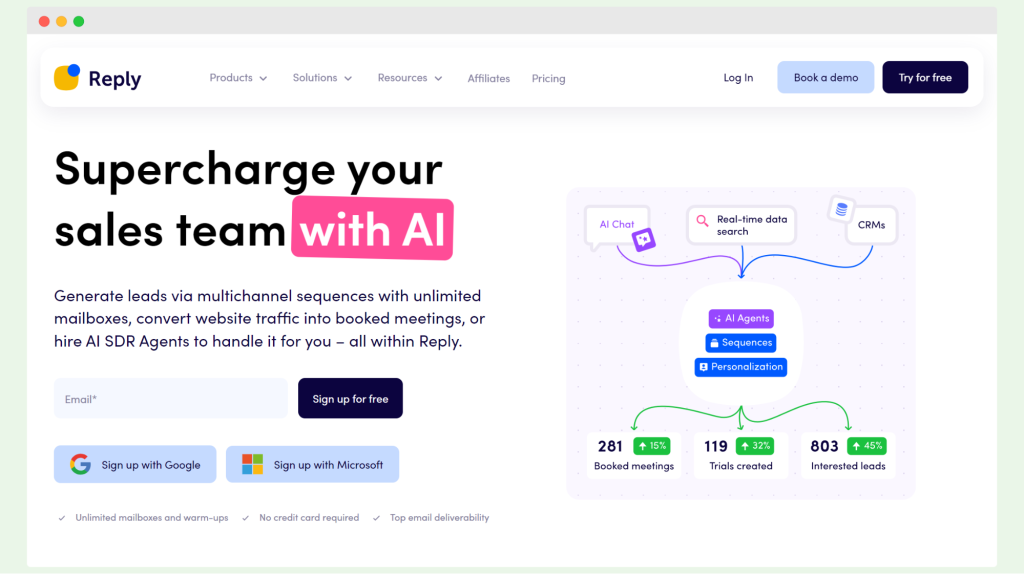
It features A/B tests, if-campaigns, follow-ups in one thread, built-in email validation, and timezone detection.
The platform also offers AI support and Reply Data—a database of business contacts for outreach.
Pricing: There are three pricing bundles: Sales Engagement (from $49), AI SDR (from $249), and AI Chat ($0 or $49), each tailored to different business needs.
User rating: 4.6/5 (G2)
However, users report limited customization options, a cluttered interface with too many labels and tags, and a lack of bundling options for emails sent to multiple contacts within the same company.
On top of that, the deliverability monitor could be improved, which necessitates the use of other platforms if you want to reach inboxes.
LinkedIn Sales Navigator – best for prospecting
LinkedIn Sales Navigator is a powerful tool that provides sales professionals with the ability to find and connect with potential clients.
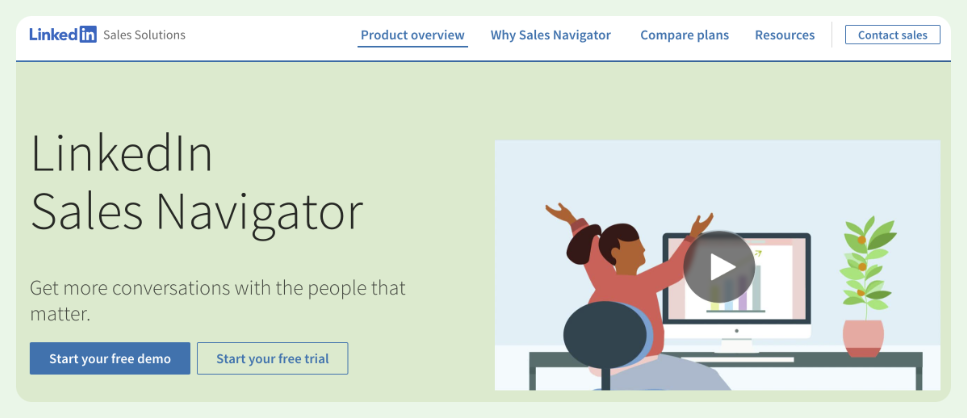
It offers advanced search capabilities, so that it is easy to navigate and quickly find relevant contacts. Users appreciate its effectiveness in building relationships on LinkedIn, the most effective social network for B2B sales.
Pricing: Starts from $70 per month. If you want advanced features like account IQ, smart links, and usage reporting, you’d need to switch to a more expensive plan –$140 per month.
User rating: 4.⅗ (G2)
As is often the case with behemoths like LinkedIn, the platform is costly, and customer support is lackluster. Additionally, the messaging filters are inadequate, and the platform’s list management features have untapped potential. Often, you’d need to use external tools to export or scrape the data.
Users also find the automatic charging after the free trial inconvenient. Sometimes, switching between Sales Navigator and LinkedIn can make it challenging to keep track of browsing modes.
Since it’s natively integrated with LinkedIn, Sales Navigator is super popular, even with its issues.
DemandBase One – best for account-based marketing
DemandBase One is a comprehensive account-based marketing (ABM) platform designed to help sales and marketing teams achieve their revenue goals with fewer resources.
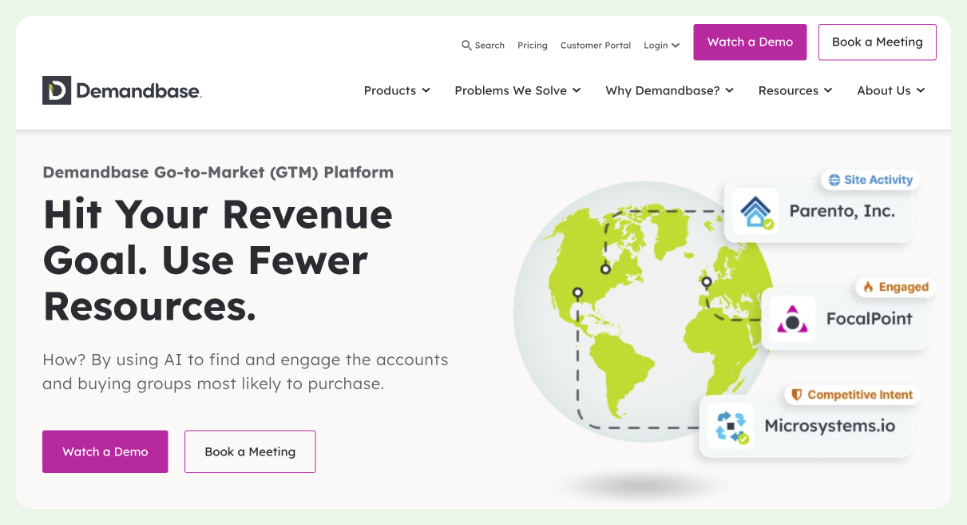
It leverages Account Intelligence to provide rich, reliable account-level insights, which enable precise audience creation and personalized engagement throughout the B2B buying journey.
The platform integrates multiple sources of intelligence and sales/marketing plays. Such an integration allows users to spot opportunities earlier, engage more intelligently, and close deals faster.
Pricing: It’s not publicly available. You would need to contact Demandbase for pricing details.
User rating: 4.3/5 (G2)
Setup can be tedious without a proper ops team. Also, users have reported issues with poor documentation, weak implementation consultants, and shoddy integrations with Salesforce and Pardot. Additionally, the reporting functionality is limited and requires external data manipulation for more complex analyses.
While DemandBase One has its issues, it remains a top choice for ABM marketers and salespeople.
Outreach – best for sales workflows
Outreach is a powerful sales engagement platform designed to help sales reps maximize revenue using AI-driven insights.

It offers features like cold email sequences, deal management, sales pipeline visualization and mutual action plans. Outreach provides an overview of the entire sales funnel and operations. The platform also includes conversation intelligence for coaching and closing more deals.
Pricing: Outreach can be costly, with implementation fees starting at $1,000 and potentially reaching up to $8,000. The initial price for the Standard plan starts at $100 per user per month and requires an annual contract commitment.
User rating: 4.3/5 (G2)
Users have reported challenges with setup, team training, and customer support, which can detract from its overall effectiveness.
Still, Outreach does manage to keep its spot at the top of the salestech landscape even with these difficulties.
Calendly – best for sales productivity
Calendly is a powerful tool for automating the scheduling aspect of the sales process, helping sales teams and sales professionals manage their appointments more efficiently.
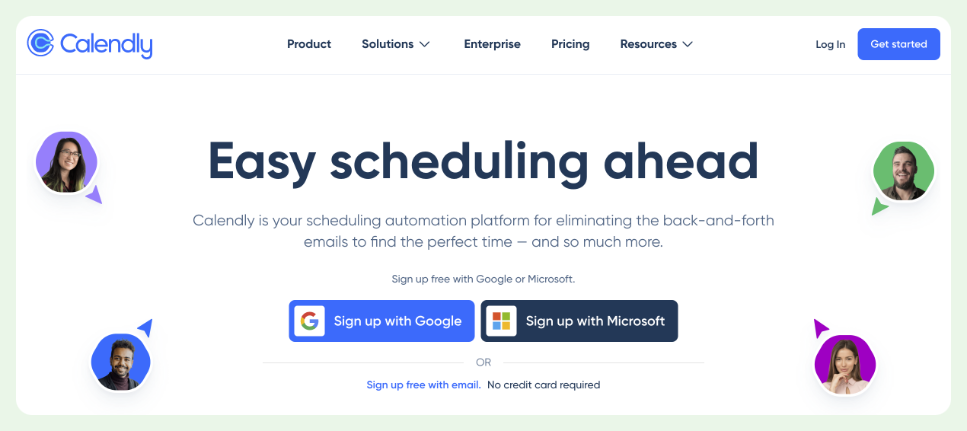
It integrates seamlessly with tools like Zoom, making it easier to coordinate sales calls. Users appreciate its simple interface and quick setup, which streamlines various sales related tasks.
Pricing: You can use most of the features on the free plan. If you want something more advanced, the starter plan is $10 per month.
User rating: 4.7/5 (G2)
Nonetheless, it has limitations, such as compatibility issues with Outlook, occasional app crashes, and basic functionality that could benefit from enhancements. The initial setup of work hours can be cumbersome, and navigating its settings can sometimes be confusing.
Despite these small problems, Calendly remains one of the best sales tools for improving sales productivity and minimizing scheduling conflicts.
Evaboot – best for LinkedIn data scraping
Evaboot is a specialized sales tool for LinkedIn Sales Navigator data scraping, designed to enhance sales prospecting and lead generation efforts.
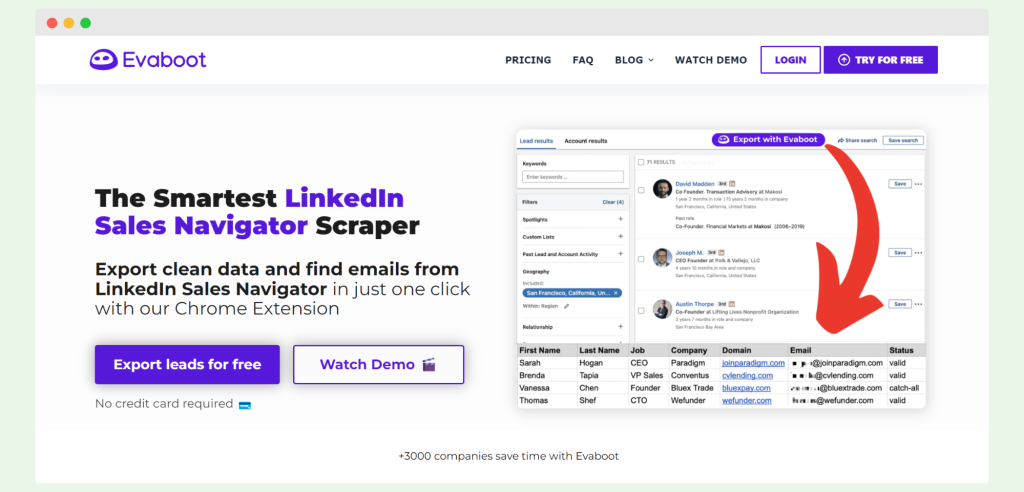
It allows sales teams to export sales leads from LinkedIn Sales Navigator in CSV format, with features like data cleaning, formatting, lead filtering, and email verification.
Evaboot helps streamline the sales process by providing sales professionals with accurate contact information, which enables more effective sales outreach.
Pricing: Starting at $9 per month with 100 credits, Evaboot also offers a free trial.
User rating: 4.6/5 (G2)
However, while it aids in sales automation and managing customer data, it lacks comprehensive sales productivity tools such as email sending, sequences, and personalization, and users report high bounce rates.
Still, Evaboot serves as a valuable tool for modern sales teams looking to improve their sales pipeline.
Salesblink – best for AI-based sales
Salesblink is an AI-driven sales engagement software designed to streamline the sales cycle and improve sales performance.
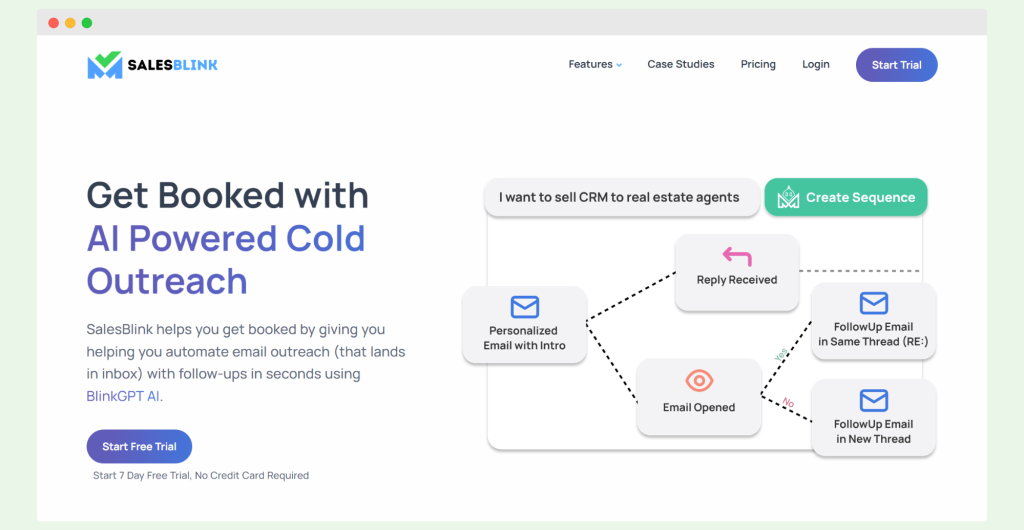
It offers sales automation tools, including AI-generated email sequences, personalized emails, a meeting scheduler, email inbox warmup, and detailed analytics dashboards. It also offers real-time insights and support for sales representatives in their daily sales tasks.
These features help sales teams enhance their sales activities and generate qualified leads.
Pricing: Starting at $25 per month with a 7-day free trial, Salesblink integrates well with other sales management tools.
User rating: 4.5/5 (G2)
Be that as it may, the outdated B2B email database and steep learning curve for advanced features can hinder the sales process.
Salesblink is still a great sales tool for increasing customer interactions and pushing next sales even with these flaws.
Vidyard – best for video prospecting
Vidyard is a video tool designed for virtual selling, allowing sales reps to create and send personalized videos throughout the entire sales process.
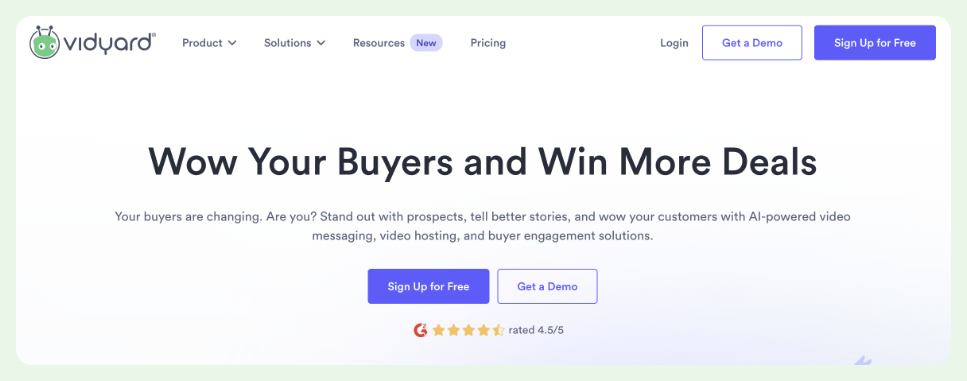
It enhances sales efforts with powerful video analytics tools and seamless integrations. Sales professionals and marketing and sales departments find it valuable for adding a personal touch to their outreach.
Pricing: The free version will mostly suffice for up to 25 videos. If you have bigger needs, the starter plan is $19 per month.
User rating: 4.5/5 (G2)
We have to mention that some users report that videos can take longer to load, the Chrome extension sometimes crashes, and the paid plans are relatively expensive. While the free version is adequate for basic use, small businesses might find the enterprise-focused pricing less appealing.
Additionally, some functionality has been removed from the free version, which can be a drawback for those needing more robust features.
Still, Vidyard stands out as a strong competitor in the video sales industry.
Monday Sales CRM – best for lead management
Monday Sales CRM is a comprehensive CRM platform that supports the entire sales process, from lead generation to post-sales activities.
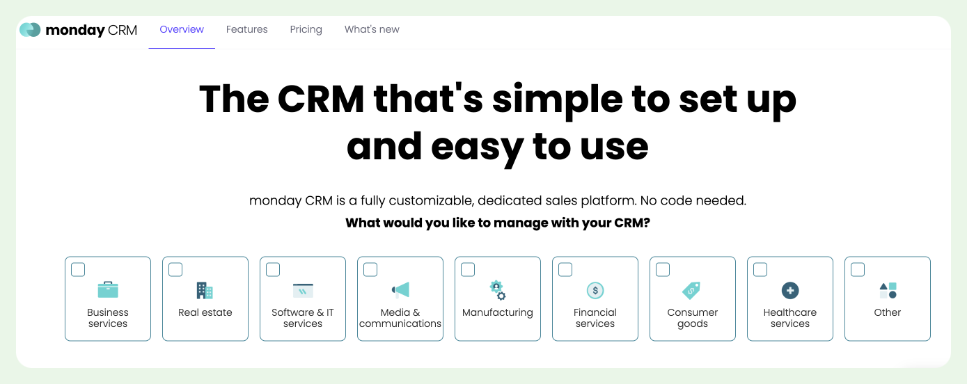
It helps sales teams manage customer data, automate sales processes, and track every deal’s status. Sales managers appreciate the real-time data provided by sales analytics tools, which help optimize sales operations and customer lifetime value.
Pricing: Starts from €12 per month per seat. You need a minimum of 3 seats per account, so that adds up to €36.
User rating: 4.6/5 (G2)
Yet, the user interface can lag, especially on the desktop version for Mac, and prioritizing tasks can be challenging. Some users find the software clunky and confusing when trying to handle all sales related tasks.
Monday Sales CRM is quite good for lead management and guarantees that no opportunities pass by unnoticed in spite of these problems.
ChurnZero – best for customer success
ChurnZero is a comprehensive platform designed to enhance customer success for subscription businesses.

It helps salespeople and marketers by identifying potential churn risks early and highlighting renewal and expansion opportunities.
The platform offers best-in-class automation, in-app communications, and Customer Success AI™ to engage customers effectively.
It has features like customer journeys, health scores, survey tools, segmentation, plays, reporting, and real-time alerts. ChurnZero integrates seamlessly with your CRM and tech stack.
Pricing: Plans are not publicly available. Reach out to ChurnZero to find out the exact pricing.
User rating: 4.7/5 (G2)
The initial setup can be challenging, especially for complex products, and some users find the Custom Table interface difficult to read. Additionally, the HubSpot sync only covers tasks, not emails or notes. Still, ChurnZero’s great feature set and first-rate customer service really appeal to users.
Scratchpad – best for sales forecasting
Scratchpad is a fast, user-friendly tool designed to simplify pipeline management and sales forecasting.
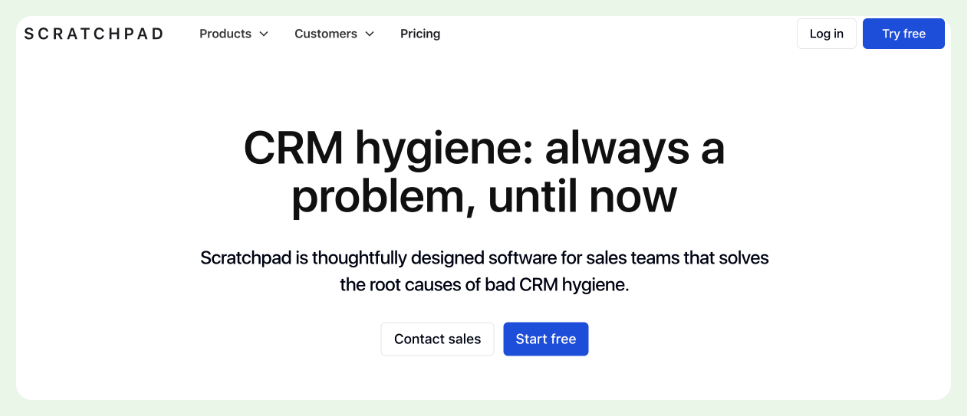
Sales leaders, reps, and revenue operations all highly regard it for its ability to streamline the sales process.
Scratchpad offers advanced features like automated deal alerts, sales trends, waterfall analytics, easy forecast rollups, and visibility into pipeline changes. This helps sales teams identify and address revenue risks as well as solve problems within their pipelines.
Pricing: Scratchpad has a free plan with rudimentary features. The plans start from $19 per month and allow more views and unlimited notes and updates.
User rating: 4.8/5 (G2)
While users appreciate its clean layout and responsive customer service, some find managing custom fields tricky and note occasional delays in note-taking. Additionally, there can be disconnections between Salesforce and Scratchpad, and the lack of O365 calendar integration is a drawback.
Scratchpad is often the first choice, though, for enhancing forecasting accuracy and sales performance.
ActiveCampaign – best for contact management
ActiveCampaign is a solid sales automation tool that combines the functionality of an email marketing platform with a comprehensive CRM system.
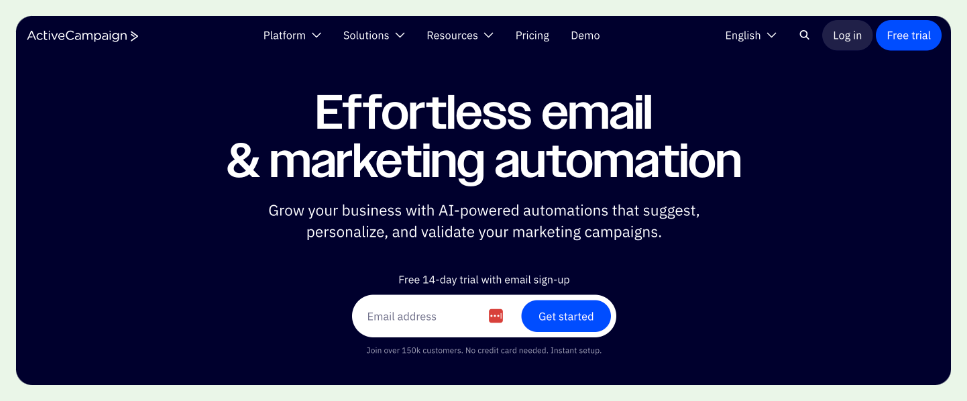
This tool allows sales reps to segment new users, update deals, and create tasks directly from the CRM, enhancing the overall sales process. It also offers advanced analytics and performance tracking for both emails and sales team members, making it easier to identify top performers.
Pricing: Starts at $15 per month.
User rating: 4.5/5 (G2)
However, users often mention a steep learning curve due to the vast number of features, which can be overwhelming at first.
ActiveCampaign is still a favorite for its strong automation and contact management features despite these early difficulties. Pricing starts at $19 per month, with a free trial available.
Salesmate – best for marketing efforts
Salesmate is a flexible and cost-effective CRM solution designed to address common pain points in sales and marketing efforts.
It allows sales teams to manage contacts, leads, and customers efficiently, thanks to built-in tools like calling, texting, pipeline management, and deal tracking.
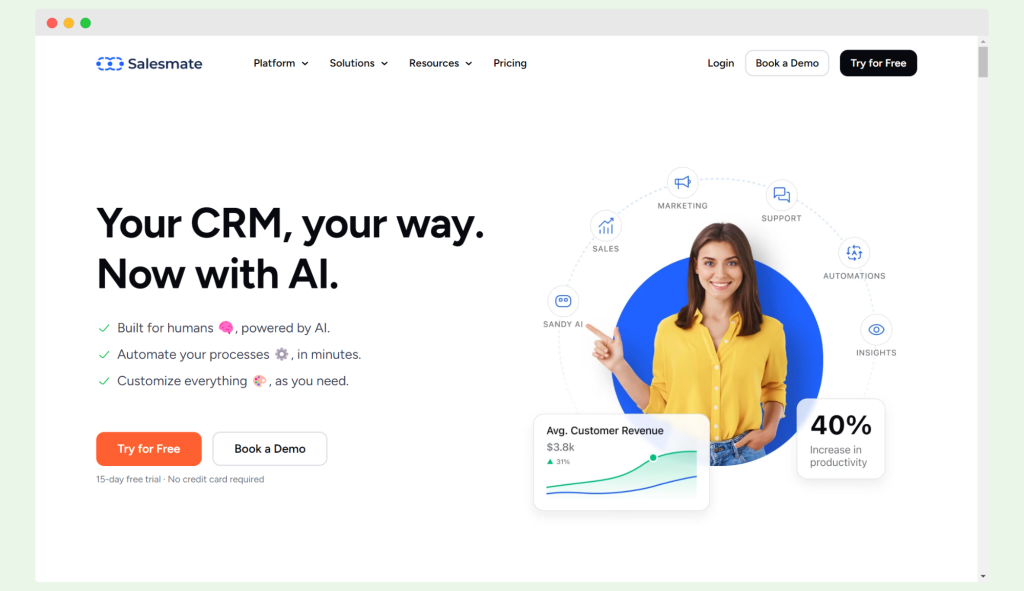
The platform’s workflows and sequences automate routine tasks, which frees up time for sales reps to focus on selling. Salesmate also empowers marketing teams to create personalized campaigns, track website visitors, and generate high-quality leads.
Pricing: A 15-day free trial is available. Plans start from $29 per month.
User rating: 4.6/5 (G2)
Some users report syncing issues with RingCentral and difficulties with importing contacts.
Notwithstanding these flaws, Salesmate provides small companies trying to improve their sales and marketing processes with a whole solution.
KrispCall – best for cloud telephony and sales communications
KrispCall is a comprehensive cloud-based phone system designed to streamline sales communications and help teams close more deals through advanced calling features.
It offers a complete suite of sales communication tools, including specific phone numbers in 100+ countries, call recording, IVR (Interactive Voice Response), call analytics, SMS capabilities, and CRM integrations with platforms like HubSpot, Salesforce, and Zoho.
KrispCall enables sales teams to manage all their voice and text communications from a unified platform, with features like call forwarding, voicemail transcription, and team collaboration tools.
Pricing: KrispCall offers flexible pricing starting with a free trial. The Essential plan begins at $15 per user per month, while the Standard plan is $40 per user per month. Enterprise plans with custom features are available for larger teams.
User rating: 4.5/5 (G2)
Some users have noted occasional call quality issues depending on internet connectivity, and the mobile app experience could be more refined compared to the desktop version.
However, KrispCall stands out as an excellent choice for sales teams looking to professionalize their phone communications, especially those operating internationally or managing remote sales teams. Its ability to integrate seamlessly with existing CRM systems makes it particularly valuable for maintaining organized customer interactions throughout the sales cycle.
Myth Buster: Choosing the right sales tools
Selecting the correct sales tools can be overwhelming, especially with the many options available. Let’s debunk some common myths and reveal the truths to help you make informed decisions.
Myth 1: All sales tools are the same
Truth: Sales tools vary significantly in features and functionalities. Evaluate each sales tool based on your specific needs, such as customer relationship management (CRM), sales automation, and sales pipeline management.
Myth 2: Expensive tools are always better
Truth: Price doesn’t always equate to quality. Many affordable sales productivity tools offer robust features that can meet your needs effectively. Assess the best sales tools based on their value and functionality.
Myth 3: One tool fits all needs
Truth: No single tool can address every aspect of the sales process. Combining multiple types of sales tools tailored to different tasks—like CRM for customer relationship management and sales intelligence software for analytics—often yields better results.
Myth 4: Implementation is quick and easy
Truth: Implementing new sales management tools can be time-consuming and complex. Plan for a learning curve and allocate time for training your sales team and integrating the tools into your existing sales processes.
Myth 5: More features are always better
Truth: Extra features can complicate usage and lead to inefficiency. Pay close attention to sales software applications that provide the tools you require and will use so they improve rather than impede sales efficiency.
Myth 6: Free sales tools are sufficient for all needs
Truth: While free sales tools can be beneficial, they often lack advanced features necessary for scaling operations. Investing in premium sales software can provide advanced analytics, marketing automation, and data integration tools crucial for growth.
Myth 7: Sales tools replace the need for a sales team
Truth: Sales tools are designed to enhance the efficiency and effectiveness of your sales team, not replace them. Human interaction remains crucial in building customer relationships and closing deals, particularly in b2b sales.
When you understand these myths and truths, you will make wiser decisions on sales tool selection, improve the performance of your sales team, and produce better results.
Key Takeaways
- The right sales tools can transform your sales cycle and enhance efficiency and effectiveness.
- ActiveCampaign excels in contact management and combines email marketing with a powerful CRM system.
- Salesmate offers a flexible and cost-effective solution for marketing automation and sales management.
- ChurnZero provides robust features for customer success and helps reduce churn and increase revenue.
- Scratchpad simplifies pipeline management and sales forecasting, making it easier for each sales rep to track performance.
- Vidyard is ideal for video prospecting and adds a personal touch to sales outreach with powerful analytics.
- Calendly streamlines scheduling and reduces administrative tasks while improving sales call coordination.
- The best sales tools offer integrations with other systems and ensure a seamless workflow for sales teams.
- Tools like Salesmate and ActiveCampaign provide automation features that save time and improve lead generation efforts.
- Understanding the specific needs of your sales team is crucial in selecting the most relevant sales tools for success.
Conclusion
Choosing the right sales tools can revolutionize your sales cycle and make processes smoother and more effective. From contact management to video prospecting, the tools mentioned can significantly enhance your sales team’s productivity.
And if the core of your sales process is cold emailing, try out Woodpecker first.
FAQ
What are the best sales tools?
The best sales tools include CRM systems like ActiveCampaign, automation platforms like Salesmate, customer success tools like ChurnZero, and prospecting tools like Vidyard and Scratchpad.
What is a sales tool?
A sales tool is a software or application designed to streamline the sales cycle and help sales reps manage customer relationships, automate tasks, and analyze sales data for improved performance.
What tools do you need to be successful in sales?
Successful sales require tools for CRM, marketing automation, prospecting, lead generation, and sales forecasting. Examples include ActiveCampaign, Salesmate, ChurnZero, Vidyard, and Scratchpad.
What are sales prospecting tools?
Sales prospecting tools help sales reps identify and engage potential customers and offer features like lead generation, contact management, and analytics, as seen in tools like Vidyard and Salesmate.
What are the 7 keys of sales?
The seven keys of sales include prospecting, building rapport, identifying needs, presenting solutions, handling objections, closing the sale, and follow-up.
What are sales CRM tools?
Sales CRM tools, such as ActiveCampaign and Salesmate, help manage customer data, track interactions, automate sales processes, and improve customer relationship management.
What is a sales toolkit?
A sales toolkit is a collection of software and resources that assist sales reps in various tasks throughout the sales cycle and includes CRM, prospecting, automation, and analytics tools.
What is the best sales skill?
The best sales skill is effective communication, which encompasses active listening, clear articulation of value, and the ability to build strong customer relationships.

